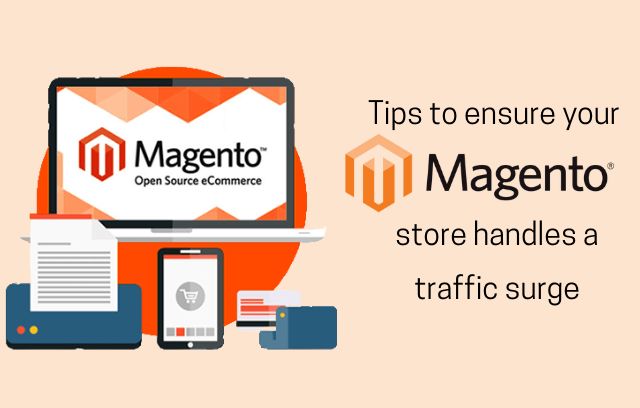Best Practices to Prepare Your Magento Store for High Traffic

High traffic equals more leads and sales. So, if you are preparing to build an online store with Magento, it should be able to draw substantial traffic. One way to do so is by offering what your customers want. That is where premium Magento extensions kick in.
Unlike free add-ons that provide basic features, paid ones allow you to add functionality as required. In short, they cater to the exact needs of your store and customer demand. These extensions cover various areas, including marketing, payments, shipping, customer service, security, and more. When visitors and customers have a better experience shopping from your site, the traffic will grow significantly. It will further generate more leads and sales.
Indeed, the profitability of your Magento online store relies on its capability to attract traffic. But it is not solely determined by traffic volume alone. The quality matters too. Remember, the traffic is a waste if you cannot convert it into leads and sales.
Also, a heavy volume of traffic can become problematic for your e-commerce store. For example, your store is ready for this rise in traffic. It will face performance issues such as slow loading or a crash.
Do you know even a one-second delay in loading your site can result in losing a potential customer? If you do not want to deal with such situations, your website should be ready to handle a traffic surge at any time. Here are the practices that help you to do so.
How to prepare your Magento store for a surge in traffic?
Whether you operate a Magento store or plan soon, it should be able to handle sudden spikes in traffic. It helps you provide customers with a seamless and satisfactory user experience.
1. Forecasting traffic surges
The first step to effectively prepare for traffic spikes is to predict when and how they might occur. To achieve this, delve into website analytics and examine essential metrics.
It is advisable to assess the average daily or weekly traffic volume over the previous few months and the peak traffic during the preceding year. Once you complete the assessment, compare metrics by estimating the percentage of traffic increase during the peak season and the average traffic during the previous six months.
Is your business dependent on seasonal demand surges? If not, use an alternative approach. It involves identifying the days and hours when your e-commerce website experiences the highest traffic load.
The question "how to obtain this data on a regular basis?" might be troubling you. Well, it is easy. First, create an Adobe Business Intelligence account. It offers most of the required analytics functionality or engaging Magento development services to develop and integrate a custom analytics solution.
2. Assess the functionality and efficiency
We hope you have an estimated idea of the potential traffic surges. Now, determine if your store can handle the anticipated influx of visitors. You can accomplish this by employing load tests using in-house resources or seeking assistance from third-party experts. Many premium Magento extensions are available that speed up the load testing while offering accurate results.
It will give a better understanding of the website's capabilities. Plus, you will receive more detailed information on the areas that require attention. As a result, you can develop and implement specific measures to enhance the website's performance. Ideally, you should conduct load testing each time you anticipate a traffic surge. Thus, you will have peace of mind that your website is ready for the increase.
3. Get your website ready for future surges
Imagine you found that your Magento online store cannot handle traffic spikes. It is time to make it ready. Follow these steps to prepare your site.
- It is crucial to start by confirming whether you are using the latest version of Magento. Even minor updates or patches can influence your site performance and data caching. Furthermore, upgrading Magento boosts website security which is crucial during seasonal demand surges. After all, hackers increase their activity during such periods.
- You can also use content delivery networks (CDNs) to ensure data caching optimization. Adobe Commerce can access the Fastly CDN by default. However, if necessary, you should employ third-party premium Magento extensions or customized content delivery solutions.
- Another approach is to increase server capacity to boost website performance, permanently or temporarily. But it enables you to handle traffic peaks.
- Lastly, opt for less drastic measures such as resizing product images or minimizing the potential load. According to the official Magento blog, 72 dpi images are the standard size.
The crux
Magento is a highly efficient platform that empowers e-commerce businesses to entice large customers and convert them into buyers. But it has some flaws, which you can manage easily. For example, not all websites can handle a significant surge in traffic, particularly during seasonal spikes. By following these steps, you can ensure it withstands high traffic. Further, you can implement free and premium Magento extensions to add the necessary functionality to your site and improve customer experience.
If you are searching for reliable add-ons for your e-commerce site, visit the official Magento extension store. A SoftProdigy, we also deal in paid extensions.
- Magento 2 Themes vs. Custom Design: Pros and Cons
- Trinket Magento Jewelry Theme: Empower Your Online Jewelry Store
- A Guide to Scale Your Jewellery Store with Trinket Magento Jewellery Theme
- 2023’s Best Magento Themes: Magento Theme Templates
- Tips for Optimal Checkout Experience to Customers on Your Magento 2 Store

